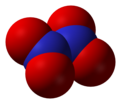Nitrogen oxide
Nitrogen oxide may refer to a binary compound of oxygen and nitrogen, or a mixture of such compounds:
- Nitric oxide, also known as nitrogen monoxide (NO), nitrogen(II) oxide
- Nitrogen dioxide (NO2), nitrogen(IV) oxide
- Nitrous oxide (N2O), nitrogen(−I,III) oxide
- Nitrosylazide (N4O), nitrogen(−I,0,I,II) oxide
- Oxatetrazole (N4O)
- Dinitrogen trioxide (N2O3), nitrogen(II,IV) oxide
- Dinitrogen tetroxide (N2O4), nitrogen(IV) oxide
- Dinitrogen pentoxide (N2O5), nitrogen(V) oxide
- Trinitramide (N(NO2)3 or N4O6), nitrogen(0,IV) oxide
- Dinitramide (N(NO2)3-)
- Nitrite (NO−
2) - Nitrate (NO−
3) - Nitronium (NO+
2) - Nitrosonium (NO+
) - peroxonitrite (ONO−
2)
The compounds NO and NO2 are radicals. In addition, there are several anions of nitrogen oxides. The most stable of these is the nitrate anion:
- Nitrate (NO3−), trioxonitrate(V) ion
but other nitrogen oxoanions include nitrite, peroxonitrite, trioxodinitrate (hyponitrate), and nitroxylate.
In atmospheric chemistry, air pollution, and related fields, nitrogen oxides refers specifically to NOx (NO and NO2).[1][2]
Only the first three of these compounds can be isolated at room temperature. N2O3, N2O4, and N2O5 all decompose rapidly at room temperature. NO3, N4O, and N(NO2)3 are very reactive.
N2O is stable and rather unreactive at room temperature, while NO and NO2 are quite reactive but nevertheless quite stable when isolated.
-
Nitric oxide, NO -
Nitrogen dioxide, NO2 -
Nitrous oxide, N2O -
Dinitrogen trioxide, N2O3 -
Dinitrogen tetroxide, N2O4 -
Dinitrogen pentoxide, N2O5 -
Trinitramide, N(NO2)3
NOx
NOx (often written NOx) refers to NO and NO2. They are produced during combustion, especially at high temperature. These two chemicals are important trace species in Earth's atmosphere. In the troposphere, during daylight, NO reacts with partly oxidised organic species (or the peroxy radical) to form NO2, which is then photolysed by sunlight to reform NO:
- NO + CH3O2 → NO2 + CH3O
- NO2 + sunlight → NO + O
The oxygen atom formed in the second reaction then goes on to form ozone; this series of reactions is the main source of tropospheric ozone. CH3O2 is just one example of many partly oxidised organic molecules that can react with NO to form NO2.
These reactions are rather fast, so NO and NO2 tend to cycle, but the sum of their concentration ([NO] + [NO2]) tends to remain fairly constant. Because of this cycling, it is convenient to think of the two chemicals as a group; hence the term NOx.
In addition to acting as a main precursor for tropospheric ozone, NOx is also harmful to human health in its own right.
NOx may react with water to make nitric acid, which may end up in the soil, where it makes nitrate, which is of use to growing plants.
See also
- Nitrogen oxide sensor
- Sulfur nitrides, which are valence isoelectronic with nitrogen oxides
References
- ^ United States Clean Air Act, 42 U.S.C. § 7602
- ^ Seinfeld, John H.; Pandis, Spyros N. (1997), Atmospheric Chemistry and Physics: From Air Pollution to Climate Change, Wiley-Interscience, ISBN 0-471-17816-0







